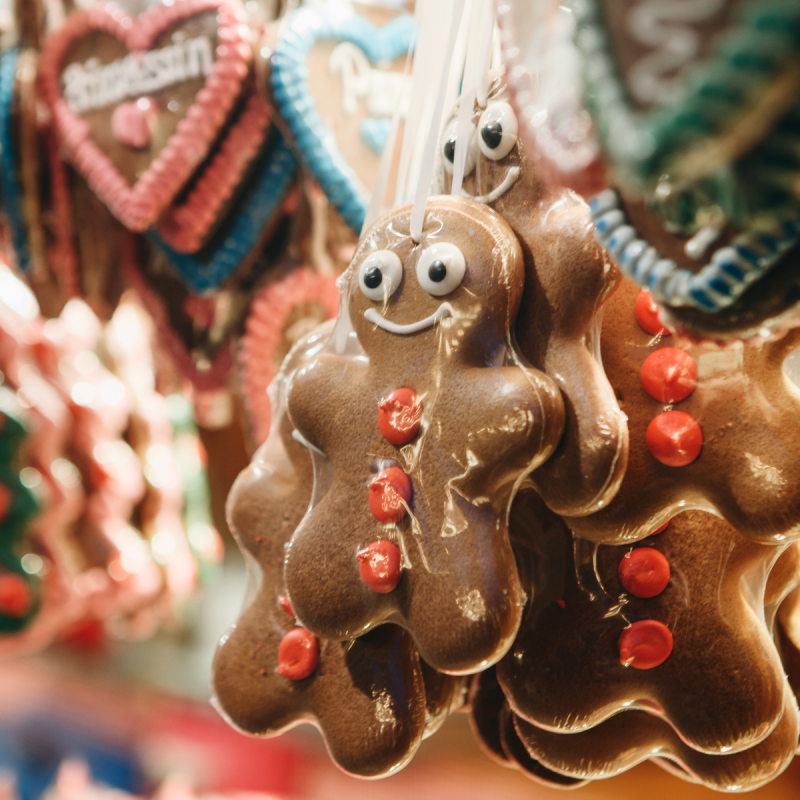
Christmas in Germany is celebrated in a different way than in other countries, especially the United States. The most important day is the 24th of December, not the 25th. It is called Heilige Nacht or Holy Night and celebrates the birth of Christ. On that day, the Christmas tree is put up and decorated. In the evening, the family gathers in another room, then a bell is rung, the door to the Christmas room is opened and everybody rushes in to admire the lights and tree and to look at their presents. They have been placed under the tree by the Weihnachtsmann, or Santa, accompanied by his helper, Christkind, an angel.
Videos by TravelAwaits
After that, it’s time for the most sumptuous dinner of the holidays, traditionally a stuffed goose, not a turkey and, if you are Catholic, you attend Midnight Mass afterward… 25th and 26th are also bank holidays, but the food is less elaborate until New Year’s Eve when there are fireworks, traditions like Bleigiessen (lead pouring to predict the future from the shapes of the melted lead that is cast into cold water) and a fish dish — carp or flounder. In between, sweets of all kinds, especially gingerbread and marzipan, and plenty of punch and mulled wine are consumed. Most years, it’s cold and snows in Germany at Christmas, so all that heavy food is most welcome, digestion is helped along by long walks in the snow and one or the other of Germany’s potent Schnaps. Christmas food in Germany means warmth, calories, and alcohol, all adhering to the untranslatable German concept of Gemuetlichkeit. (vaguely, coziness.)
Here are the most traditional and delicious German Christmas foods.

1. Roast Stuffed Goose
Goose or duck are the most traditional roasts for Christmas Eve dinner, the most important day of the season. The goose is stuffed with red, tart apples and chestnuts and roasted to a crisp as the skin is also appreciated. The bird is served with red cabbage, gravy, and potato dumplings. The shredded red cabbage is cooked with cloves and a dollop of black currant glee.
2. Carp Blue
Carp, trout, or any kind of seafood, including oysters, are the traditional dishes on New Year’s Eve. Carp, however, is most popular and easy to come by in Germany. Or else it’s ordered from the fishmonger. The carp is either baked or grilled, but mostly enjoyed “blue.” This means the fish is cooked in a mixture of white wine, water, and vinegar (that gives it the blue color), with onions and laurel leaves added. The carp is served with boiled potatoes. A NewYear’s tradition adheres to the carp: if a scale of the fish is kept in one’s wallet all year, one will never run out of money.

3. Bunte Teller (Mixed Sweets)
Something that always awaits each family member under the Christmas Tree is the Bunte Teller. It is a paper plate, covered in gold foil or Christmas paper and filled with all the sweet goodies of a German Christmas. There are home-baked cookies, miniature chocolate Santas, marzipan potatoes, and individually wrapped slices of Weihnachtsstollen as well as bags of chocolate gold coins for good luck.
4. Weihnachtsstollen (Fruit Bread)
Weihnachtsstollen, also known as Christstollen, was already a traditional Christmas sweet during the Middle Ages. The word fruit bread doesn’t do it justice because it’s much more. The most famous and popular comes from Dresden where it is also known as Strietzel. The loaf is made from 50 percent butter (never margarine or other fat), flour, and yeast. The dough is stuffed with raisins, chopped candied fruit, almonds, and nuts and covered with a thick layer of powdered sugar. The loaf has tapered ends and a fold on the side to make it resemble baby Jesus, swaddled in cloth. Many families who have traditional recipes bake the stollen themselves, otherwise, it’s store bought or ordered online. To keep the stollen moist, it is kept in special tins and eaten with a cup of coffee. Stollen is a favorite dessert, too.

5. Baked Apples
The scent of baked apples is synonymous with Christmas in Germany. Big, red apples are cored, then filled with almonds, raisins, marzipan, and other dried fruit, often sprinkled with rum and baked in the oven until tender and wrinkly. The apples are served hot with vanilla sauce or vanilla ice cream.
6. Marzipan
Marzipan originated in the Middle East and came via the Arabs and Spain to Europe. This Christmas delicacy is made from ground almonds, rose water, and sugar. The finest marzipan in Germany is made in Koenigsberg and Luebeck and comes in all shapes and forms. No Bunter Teller is complete without a Luebecker Marzipanbrot and a handful of marzipan potatoes. The marzipan bread is shaped like a loaf and covered in fine, dark chocolate. Some have pineapple pieces and juice mixed into the marzipan mass. The potatoes are soft marzipan balls, dusted with a coating of cinnamon and cocoa powder. But, other things are made from marzipan, too, like angels, pigs (important for New Year’s as the pig in Germany is a symbol of good luck), hearts, and much more. These marzipan figures are painted with food color and are dried to make them last. Another variety is called persipan. Instead of almonds, ground peach or apricot kernels are used. Persipan is cheaper than marzipan.

7. Spekulatius
Spekulatius are flat, square shortcrust cookies that are imprinted often with a relief of religious motifs. The name comes from the Latin word for mirror: speculum. Another version says, that the name comes from St. Nicholas who is also called the “observer” or speculator because the cookies were a traditional gift to children on December 6, Nicholas Day. Often hand-carved wooden forms are pressed into the shortcrust dough before baking for only a few minutes to turn the cookies golden brown. Ground cloves, cinnamon, and cardamom are added to the dough to give the spekulatius their distinct spicy flavor.

8. Lebkuchen (Gingerbread)
As opposed to the square, hard spekulatius, Lebkuchen is round, often heart shaped, soft, and fluffy. It has its origins in Germany in the 13th century in the monasteries around Nuremberg. Apparently, the monks were very fond of strong, dark beer and found this pastry helpful with digestion and against stomach pain. Lebkuchen is very sweet because it contains a lot of honey, but that is counterbalanced by the addition of spices like cinnamon, anise, ginger, cardamom, cloves, and black pepper. Hence the medicinal properties! The Romans and Egyptians already sweetened pastries with honey, but the monks developed lebkuchen to perfection. Before baking it, they set it on thin wafers so it wouldn’t stick to the baking tray.
During the Middle Ages, Nuremberg was an important trade center, therefore the exotic spices that went into Lebkuchen were easy to come by, and ever since, the city has been the most famous manufacturer of lebkuchen. No Christmas in Germany without a tin of lebkuchen! A lot of art and effort goes into the tins, too, that have become collectors’ items.

9. Gluehwein (Mulled Wine)
Gluehen is the German word for “to glow,” and the German mulled wine makes you glow in every sense, as it is a potent concoction. The best red wine is a Coté du Rhone or merlot, it needs to be a dry wine. The bottle is emptied into a pot, then orange slices, orange juice, anis, cloves, cinnamon, and sugar are added. It’s heated up but not boiled and then comes a generous measure of rum.
The mulled wine is served hot in glasses with a handle. Gluehwein is a favorite drink at any German Christmas market. There is also alcohol-free gluehwein sold at Christmas markets so kids can have a sip, too.
10. Feuerzangenbowle (Fire Tongue Punch)
This alcohol-packed Christmas drink is prepared in a ceremony. You need a copper pot, dry red wine, cinnamon, lemon, cloves, a sugar loaf, at least 48 percent rum, and oven tongs. Red wine and spices are heated in the copper pot, the sugarloaf is placed over the pot with the tongs and drenched with rum. The sugarloaf is then set alight. As the rum burns off, it melts the sugar which drips into the pot below. Then rum is added until all of the loaf is gone. It’s served with a ladle into the same kind of glasses as Gluehwein. Be careful though where you celebrate the Feuerzangenbowle because of the flames. The drink might set your insides on fire and make your cheeks glow, and mind the flames in your home.

11. Weihnachtsplätzchen (Christmas Cookies)
Baking Christmas cookies is a favorite pre-Christmas occupation in German households. Kids love to make their own creations and, of course, to lick the pot when all is in the oven. Cookie cutters help to produce the cookies (favorite shapes are stars, angels, half moons, and animals.) Added spices are anis, vanilla, and cinnamon, and the cookies are decorated with chocolate flakes, nuts, almonds, sugar, and plenty of food color. Eaten with a good cup of coffee, the cookies are also pierced and hung with gold thread on the branches of the Christmas tree.
Different holiday traditions are celebrated worldwide:
